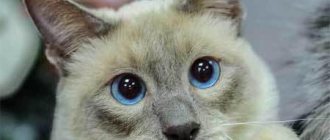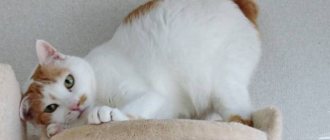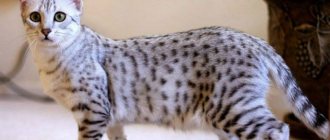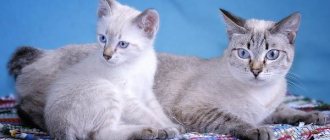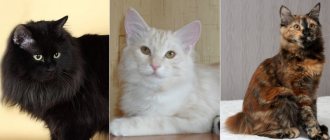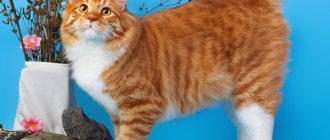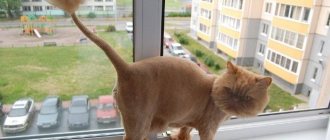The history of the American Bobtail begins in the 60s of the last century. They are distinguished by their short stubby tail. This is not a defect or circumcision, but is directly the result of a genetic mutation. These cats come in short- and long-haired varieties, and both are distinguished by excellent health. The reasons lie in genetics.
The American Bobtail is not related to the Japanese, despite its similar appearance. The short tail of the first one was the result of a dominant mutation, and the Japanese one was due to a recessive one. These cats are distinguished by their stature and large size. Beautiful and striped American bobtails, like the similar-looking spotted mini-lynx pixie bobs, are considered a national treasure of the United States of America.
Origin of the American Bobtail breed
The origin of the American Bobtail breed is connected with a touching story, in which the cat’s tail played an important role. Sounds intriguing, right?
The events took place in America in the 60s of the last century. A couple traveling in Southern Arizona picked up a stray kitten. The husband and wife took pity on the poor creature with its tail cut off and brought it home.
How could the spouses know that the baby got his “chopped off” tail not as a result of any injury, but as a result of a mutation. This became clear much later, when the adopted child grew up and acquired his own offspring from an ordinary yard cat who lived at that time in the house of his new owners.
The couple discovered that all the newborn kittens born to their cat had the same short tails as their pet, found in Arizona. This was a real surprise. We can say that this same foundling became the first representative of the American Bobtail breed.
The first Yankee Bob breeders tried to breed these animals by crossing representatives of the same breed with each other, which almost led to the extinction of the entire species. After unsuccessful experiments, they abandoned this idea, using ordinary domestic cats and representatives of cats with stubby tails to maintain the breed, searching for them throughout the country. The American Bobtail standard was developed in 1970, but the breed received official recognition by the American TICA association only in 1989.
Origin story
The history of the origin of the Kurilian Bobtail cat breed dates back to ancient times. Animals were brought to Japan from the Himalayan Islands. The animal attracted the attention of wealthy Japanese, who appreciated the good intelligence and courageous nature of their pets.
They were treated with respect and protected. At the same time, they often ran away for a walk in nature. This is how we ended up on the Kuril Islands. The Sakhalin Bobtail gradually got used to life in nature, as a result of which its appearance also changed.
The main activities of the first cats on the island were: catching rats, hunting and fishing trips with their owners. The ancestors of the Kamchatka Bobtail are the Siberian cat breed. They were brought to the Kuril Islands by settlers who quickly took a liking to the pets.
Soon after the Kuril Islands, people learned about such an unusual breed in Russia. The Russian military, who served in Japan at that time, began to import cats to their homeland en masse.
After the collapse of the USSR, the first Kuril Bobtail appeared in Moscow, and they decided to give it the name Chip. After which breeders began to actively breed new representatives of the breed. The first cat was bred by feminologist Olga Mironova at the end of the 20th century. The first nursery appeared in the country; it was opened in Moscow in 1996, which is still operating to this day.
After the appearance of an exclusive breed without a tail in Russia, similar clubs for Kuril Bobtail lovers also began to form in European countries.
Appearance
Wool
Bobtail wool is somewhat harsh to the touch, does not fit tightly to the body and has a double layer.
Snow bob (another name for American bobtails) comes in two types:
- short-haired (more hair on the belly);
- semi-longhaired (distinguished by increased shaggyness on the belly, chest, paws, tail, due to which they look somewhat disheveled).
Initially, Yankee Bob cats were long-haired, but gradually representatives of this breed with short hair appeared.
Color
Yankee Bob coat color can vary:
- white;
- cream;
- black;
- blue;
- chocolate;
- with and without white splashes;
- striped;
- tabby
Preference is given to “wild” colors - striped tabby color.
Standards: size, weight
On average, the lifespan of bobtails is eleven to fifteen years. They have a strong muscular body - the animals are very active and mobile. They reach 4-7 kg in weight. Males are larger than females.
The head is wedge-shaped with rounded contours and a concave curve between the forehead and nose.
Eyes. Yankee bobs have almond or round eye shapes. The color of the iris can vary and should be combined with the color scheme of the coat.
The ears are wide at the base, with rounded tips.
tail is short and flexible. It can be curved, slightly twisted at the end or straight. It is impossible to find two representatives of this breed with absolutely identical tails. Each kitten in the litter has tails of different lengths. In adult individuals, the tail length is at least two and a half and no more than eight centimeters.
Description of the Kurilian Bobtail
Although the history of origin goes back several decades, the breed has not yet been fully formed. Disputes arise between breeders over the standards of appearance of Kurils. It is believed that Kuril cats should be similar to their ancestors, Japanese bobtails. Short hair, massive shapes and an important distinctive feature - a small pom-pom tail - are a standard set of characteristics for the progenitors from Japan.
Appearance
Important characteristics of the breed include medium body size, small tail, slanted eyes, and short hair.
Body, paws, tail
According to the description of the TICA felinological system, the standard is considered to be a strong build, but of medium body size. The weight of cats is less than that of males, it reaches five kilograms, while males weigh 5-7 kg.
The typical body structure is compact, massive (semi-cobby), well developed. The croup is raised, the front legs are shorter in length than the hind legs, the legs are strong and muscular.
Pedigree cats have no tail or it is short with two or more bends or spirals. The length depends on the type of cat's fur. In short-haired ones, it is usually no more than 8 cm, while in long-haired ones it reaches 13 cm. The standard number of vertebrae is from 2 to 10.
Head, muzzle, ears
The head is round, trapezoidal in shape. The ears are wide, resemble a rounded triangle, set quite high on the top of the head, have a slight slope forward, and are located relative to each other by the width of the base. They are crowned with tassels.
The muzzle is large with a straight nose, round chin and large slanted eyes that look like a nut. The color of the eyes affects the color of the coat. The eyes are bright, prominent, green or yellow. Standard blue is found in representatives of colors in which white predominates.
Standard colors and coats
The color range includes traditional striped chocolate, gray, and rarely black. Red color is common, although white is attractive to breeders.
Sometimes a cat’s fur coat is decorated with patches of white spots on any part of the body, for example, on the paws, belly or chest of the animal.
Bobtails have short hair and a weak undercoat. But, as a descendant of Siberian cats, the Kurilian can have medium hair, especially long hair on the tail and hind legs.
It is important to remember that if a person is allergic to wool, then even short-haired pets are contraindicated for him.
Tails
A short tail, a pom-pom, or no tail at all is the norm for the Kuril Bobtail. The length of the tail reaches eight centimeters and has several shapes:
- The “stump” is a straight or downward curved tail, consisting of 2-8 deformed vertebrae.
- The “broom” shape has the greatest length, a straight tail, which usually has from 5 to 10 vertebrae.
- The same number of vertebral discs as in the "spiral" shape. This common type of tail is characterized by a hooked and spiral bend.
- A departure from the standard is the “retracted bobtail” shape. The tail is straight, consisting of 5-7 vertebrae, twisting into a loop closer to the tip.
Health and care features
Snowbobs are distinguished by good health. Since the breed was bred naturally, the animals do not have a predisposition to genetic diseases. However, they may experience musculoskeletal problems due to their shortened tail.
Cats are easy to care for. It is enough to brush your pet regularly and bathe it from time to time. Nails should be trimmed every two weeks. Wipe the corners of your eyes with a cotton pad and check your ears once a week.
To avoid excess weight and digestive problems, try to minimize feeding your pet food with a high level of carbohydrates. Feed mainly meat (proteins and fats). It’s even better to use balanced professional food.
Kitten in the house
Kurilian Bobtail kittens are very active and love to run. Therefore, they need a lot of free space. To diversify your favorite pet’s leisure time, you can install a cat simulator at home, consisting of all sorts of labyrinths.
Care and feeding
You need to find out from the breeder what to feed the kitten. It is better to start feeding with milk, gradually adding special food for kittens, but it is advisable to start giving it no earlier than 2 months after birth.
Weight by month
For each age interval, a Kurilian Bobtail kitten must reach a certain weight. The weight should be something like this:
- A cat should weigh 750 g, a cat should weigh 800 g in 45 days;
- 1100–1500 grams - optimal for 2 months;
- at 6 months the weight of the female should reach 3 kg, and the male - 4 kg;
- the weight of an adult cat is 3.5–5.5 kg, a male cat is 5–7 kg.
How to name a kitten
Ideal nicknames would be short and masculine names. If a person does not know what to name a cat, then an excellent name for cats would be: Billy, Cherry, Bob, Johnny, Teddy, Ollie. Cats can be called: Bonnie, Sally, Jackie, Kitty.
They also respond to names with hissing or dull sounds as part of the word. Or you can choose names based on the color of the animal, for example: Tiger or Lynx.
Character of the American Bobtail
Friend
Yankee Bobs do not like confined spaces. They do not tolerate changes of environment and separation from their owner well. These are very loyal animals. They become very attached to humans and need love and affection. These cats do not deprive any of the family members of their attention. Having a gentle character, they easily get along with other animals in the house.
Nanny
Bobtails are very cheerful, playful and have a good disposition. Therefore, they treat children calmly. If they are offended, they will simply move away and keep their distance without showing aggression.
Student
Cats quickly get used to order. They are quite talkative and can produce a range of sounds. They easily master tricks and even stage performances.
Buy an American Bobtail?
Nurseries for breeding snow beans are located only in their homeland - in the USA. Due to the increased demand for kittens, they are booked in advance.
There may be private breeders in Russia, but there is a huge risk of purchasing an animal that has nothing to do with this breed instead of a purebred American Bobtail. The best place to look for short-tailed kittens is at shows.
How to choose a kitten
Kittens
Buying American Bobtail kittens is not an easy matter. This is because this breed is not very common in Russian nurseries, and you may have to wait a long time for a new family member. Before purchasing, you should familiarize yourself with the package of documents for the animal, including the pedigree of its parents.
At one time, unscrupulous breeders classified the breed as experimental, and, as a result, they had several loopholes to deceive the future new owner of the American Bobtail. Therefore, in order not to be fooled, you should definitely check the club to which the child’s parents are registered, and then also check the information received with representatives of the association. They can provide information about the breeder's reputation.
